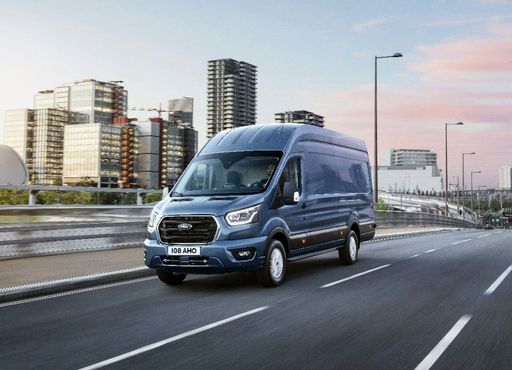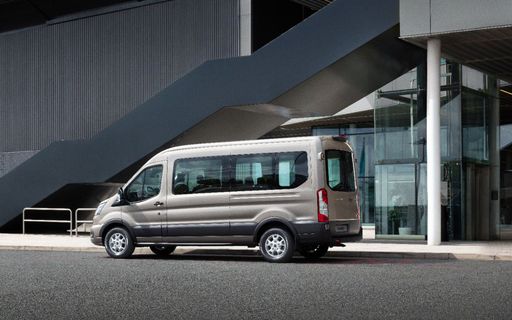Ford Transit Transporter vs Nissan Primastar Bus – Performance, range & efficiency compared
Compare performance, boot capacity, efficiency and price at a glance.
Find out which car is the better choice for you – Ford Transit Transporter or Nissan Primastar Bus?
Costs and Efficiency:
Price and efficiency are often the first things buyers look at. Here it becomes clear which model has the long-term edge – whether at the pump, the plug, or in purchase price.
Nissan Primastar Bus has a hardly perceptible advantage in terms of price – it starts at 38500 £, while the Ford Transit Transporter costs 39900 £. That’s a price difference of around 1437 £.
Fuel consumption also shows a difference: Nissan Primastar Bus manages with 6.90 L and is therefore a bit more efficient than the Ford Transit Transporter with 7.90 L. The difference is about 1 L per 100 km.
Engine and Performance:
Power, torque and acceleration say a lot about how a car feels on the road. This is where you see which model delivers more driving dynamics.
When it comes to engine power, the Ford Transit Transporter has a distinct edge – offering 269 HP compared to 170 HP. That’s roughly 99 HP more horsepower.
In terms of top speed, the Nissan Primastar Bus performs distinct better – reaching 180 km/h, while the Ford Transit Transporter tops out at 120 km/h. The difference is around 60 km/h.
There’s also a difference in torque: Ford Transit Transporter pulls slightly stronger with 430 Nm compared to 380 Nm. That’s about 50 Nm difference.
Space and Everyday Use:
Cabin size, boot volume and payload all play a role in everyday practicality. Here, comfort and flexibility make the difference.
Seats: Nissan Primastar Bus offers evident more seating capacity – 9 vs 6.
In curb weight, Nissan Primastar Bus is slight lighter – 1952 kg compared to 2074 kg. The difference is around 122 kg.
In maximum load capacity, the Ford Transit Transporter performs decisively better – up to 14100 L, which is about 8400 L more than the Nissan Primastar Bus.
When it comes to payload, Ford Transit Transporter significantly takes the win – 2607 kg compared to 1002 kg. That’s a difference of about 1605 kg.
Who wins the race?
The Ford Transit Transporter proves to be is largely superior and therefore becomes our DriveDuel Champion!
Ford Transit Transporter is the better all-rounder in this comparison.
 @ Ford Motor Company / Ford Media Center
@ Ford Motor Company / Ford Media Center
Ford Transit Transporter
Ford Transit Transporter
The Ford Transit Transporter has long been a staple in the commercial vehicle sector, renowned for its reliability and versatility. It offers a comfortable cabin with a modern design that enhances the driving experience, making long journeys more enjoyable. With a focus on practicality, the Transit provides ample cargo space, meeting the demands of businesses and individual users alike.
details @ Ford Motor Company / Ford Media Center
@ Ford Motor Company / Ford Media Center
 @ Ford Motor Company / Ford Media Center
@ Ford Motor Company / Ford Media Center
 @ Ford Motor Company / Ford Media Center
@ Ford Motor Company / Ford Media Center
Nissan Primastar Bus
The Nissan Primastar Bus offers a comfortable and versatile driving experience ideal for both urban and long-distance journeys. Its interior is spacious and well-designed, providing ample room for passengers and luggage. With a focus on practicality and efficiency, this vehicle is a solid choice for families and businesses alike.
details
 @ Ford Motor Company / Ford Media Center
@ Ford Motor Company / Ford Media Center
|
|
|
|
|
Costs and Consumption |
|
|---|---|
|
Price
39900 - 69100 £
|
Price
38500 - 63200 £
|
|
Consumption L/100km
7.9 - 10.3 L
|
Consumption L/100km
6.9 - 8.8 L
|
|
Consumption kWh/100km
21.3 - 32 kWh
|
Consumption kWh/100km
-
|
|
Electric Range
247 - 317 km
|
Electric Range
-
|
|
Battery Capacity
68 kWh
|
Battery Capacity
-
|
|
co2
0 - 270 g/km
|
co2
181 - 232 g/km
|
|
Fuel tank capacity
70 L
|
Fuel tank capacity
80 L
|
Dimensions and Body |
|
|---|---|
|
Body Type
Cargo Van
|
Body Type
Bus
|
|
Seats
3 - 6
|
Seats
6 - 9
|
|
Doors
4
|
Doors
4 - 5
|
|
Curb weight
2074 - 2765 kg
|
Curb weight
1952 - 2527 kg
|
|
Trunk capacity
-
|
Trunk capacity
-
|
|
Length
5531 - 6704 mm
|
Length
5080 - 5480 mm
|
|
Width
2059 mm
|
Width
1956 mm
|
|
Height
2530 - 2778 mm
|
Height
1935 - 2040 mm
|
|
Max trunk capacity
9300 - 14100 L
|
Max trunk capacity
4700 - 5700 L
|
|
Payload
735 - 2607 kg
|
Payload
543 - 1002 kg
|
Engine and Performance |
|
|---|---|
|
Engine Type
Diesel, Electric
|
Engine Type
Diesel
|
|
Transmission
Manuel, Automatic
|
Transmission
Manuel, Automatic
|
|
Transmission Detail
Manual Gearbox, Automatic Gearbox, Reduction Gearbox
|
Transmission Detail
Manual Gearbox, Dual-Clutch Automatic, Automatic Gearbox
|
|
Drive Type
Front-Wheel Drive, Rear-Wheel Drive, All-Wheel Drive
|
Drive Type
Front-Wheel Drive
|
|
Power HP
105 - 269 HP
|
Power HP
110 - 170 HP
|
|
Acceleration 0-100km/h
-
|
Acceleration 0-100km/h
-
|
|
Max Speed
120 km/h
|
Max Speed
161 - 180 km/h
|
|
Torque
310 - 430 Nm
|
Torque
300 - 380 Nm
|
|
Number of Cylinders
4
|
Number of Cylinders
4
|
|
Power kW
77 - 198 kW
|
Power kW
81 - 125 kW
|
|
Engine capacity
1996 cm3
|
Engine capacity
1997 cm3
|
General |
|
|---|---|
|
Model Year
2019 - 2024
|
Model Year
2022 - 2025
|
|
CO2 Efficiency Class
G, A
|
CO2 Efficiency Class
G
|
|
Brand
Ford
|
Brand
Nissan
|
What drivetrain options does the Ford Transit Transporter have?
Available configurations include Front-Wheel Drive, Rear-Wheel Drive or All-Wheel Drive.
The prices and data displayed are estimates based on German list prices and may vary by country. This information is not legally binding.
